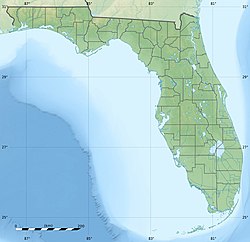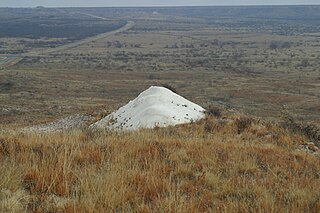
Mount Blanco is a small white hill — an erosional remnant — located on the eastern border of the Llano Estacado within Blanco Canyon in Crosby County, Texas. With Blanco Canyon, it is the type locality of the early Pleistocene Blanco Formation of Texas and Kansas, as well as the Blancan fauna, which occurs throughout North America. Mount Blanco is a Late Blancan age site, and is associated with other Late Blancan sites from Texas such as Red Light and Hudspeth local faunas from Hudspeth County, and the Cita Canyon fauna from Randall County.

The Thomas Farm site is an Early Miocene, Hemingfordian assemblage of vertebrate fossils located in Gilchrist County, northern Florida.
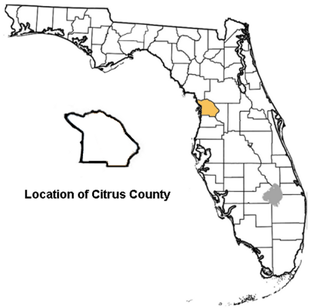
The Inglis quarry or Inglis quarry sites 1A and 1C are assemblages of vertebrate fossils dating from the Pleistocene ~1.8 Mya—300,000 years ago, located in the phosphate quarries near the town of Inglis, Citrus County, northern Florida.
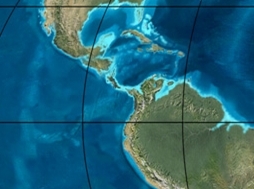
The Castillo Formation is an Early Miocene geologic formation in the Falcón Basin of Venezuela. The formation unconformably overlies the Matatere, Misoa, El Paují and Jarillal Formations. The Castillo Formation is overlain by Quaternary alluvium and in places by the Capadare Formation. The formation, deposited in a calm near-shore lagoonal brackish environment, with possibly fluvial influence, has provided a rich assemblage of fossil crocodylians, turtles, giant sloths and various types of fish.

The Haile Quarry or Haile sites are an Early Miocene and Pleistocene assemblage of vertebrate fossils located in the Haile quarries, Alachua County, northern Florida. The assemblage was discovered during phosphate mining, which began in the late 1940s. Haile sites are found in the Alachua Formation. Two sites within the Ocala Limestone yielded Upper Eocene Valvatida and mollusks.

The Jefferson County, Florida paleontological sites are assemblages of Mid-Miocene to Late Pleistocene vertebrates from Jefferson County, Florida, United States.

The Hawthorn Group is a stratigraphic unit of Miocene age in South Carolina, Georgia, and Florida, in the United States. It is known for its phosphate rock resources, and for its rich assemblages of Neogene vertebrate fossils.
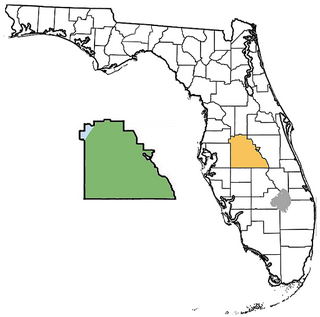
The Polk County paleontological sites are assemblages of Early Miocene to Late Pleistocene vertebrates occurring in Polk County, Florida, United States.

The Choptank Formation is a geologic formation in Virginia and Maryland. It preserves fossils dating from the Miocene epoch of the Neogene period.

The Punchbowl Formation is a sedimentary sandstone geologic formation in the northern San Gabriel Mountains, above the Antelope Valley in Los Angeles County, southern California.
The Jewett Sand Formation is a geologic formation in California, USA. It preserves fossils dating back to the Miocene Epoch of the Neogene period.
The Gracias Formation is a geologic formation in Honduras. The mainly sandstones, siltstones and claystones preserve vertebrate fossils dating back to the Neogene period.
The Curré Formation is a geologic formation of the Taraba Basin Group in Costa Rica. The deltaic conglomerates preserve fossils dating back to the Late Miocene to Early Pliocene period (Hemphillian).
The Weissenegg Formation is a geologic formation in Austria. It preserves fossils dating back to the Miocene period.
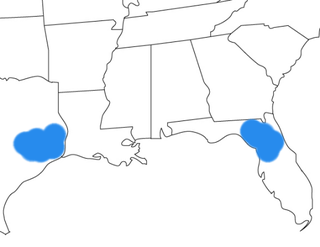
Floridachoerus olseni is an extinct peccary that lived during the Hemingfordian age of the Early Miocene, and was endemic to North America. F. olseni was in existence for approximately 4.46 million years. Remains of this extinct mammal were located at the fossil rich Thomas Farm site in Gilchrist County, Florida and Toledo Bend site, Newton County, Texas. Floridachoerus olseni was named after Stanley. J. Olsen of the Florida Geological Survey in 1962. Olsen previously worked at the site for Harvard University.
The Onzole Formation is an Early Pliocene geologic formation in the Borbón Basin of northwestern Ecuador. The formation consists of a shallow marine sandstone member containing many fish fossils, among which megalodon, and a deep water member comprising tuffaceous shales and mudstones containing gastropods, bivalves and scaphopods.

The Calvert Formation is a geologic formation in Maryland, Virginia, and Delaware. It preserves fossils dating back to the early to middle Miocene epoch of the Neogene period. It is one of the three formations which make up the Calvert Cliffs, all of which are part of the Chesapeake Group.

